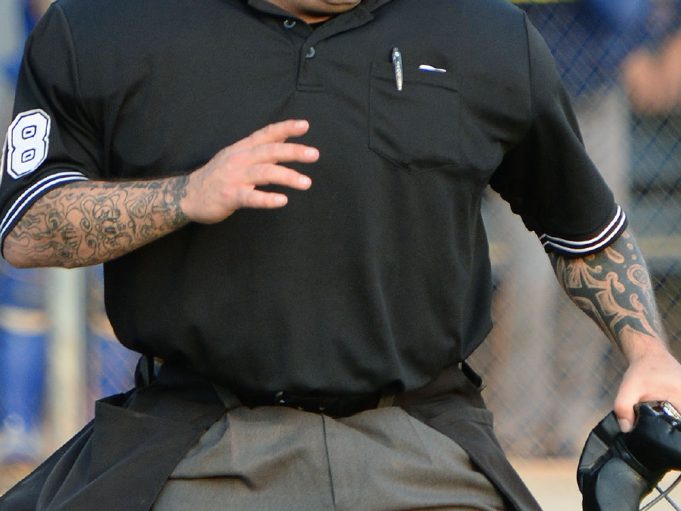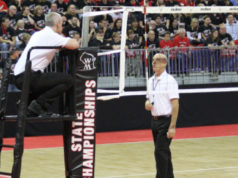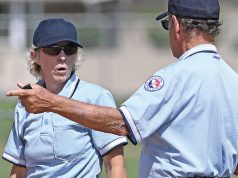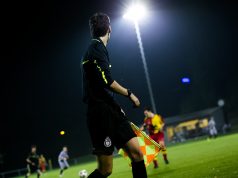Beards and tattoos have become much more prevalent and accepted in today’s society than in years past. You see them on everyone from CEOs to TV commentators to players throughout Major League Baseball, the NFL and the NBA. Many officials and assigners have started asking “does appearance still matter if you get the calls right?”
In many ways officiating is still ruled by the traditions of the past, at least at the higher levels. Take Minor League Baseball for instance where the rulebook for umpires clearly states, “Umpires should be clean shaven; mustaches, goatees and other facial hair are not permitted.”
“That policy has always been in place (for the minor leagues),” Dusty Dellinger, director of umpire development for Minor League Baseball since 2014, said of beards. “It’s more of a professional look. It’s something we go over initially. I don’t think (it will change).”
The minors are a little more lenient regarding tattoos.
“I’ve seen a growing number of tattoos,” Dellinger said. “Some are visible. It’s kind of a generational thing. You have a lot more guys covering their arms. We look at it on a per-case basis.”
Major League Baseball isn’t as restrictive, but you can’t get there without first calling balls and strikes in the minors.
Despite the traditional language in the rulebook, feelings on the topic have changed with time.
Dellinger recalled being in umpire school in 1996. He said an instructor told him then if someone showed up with a beard or tattoo “they might not be hired.”
Beards are “a trend in our culture today,” Dellinger said. “Our society goes through cycles.”
Rules for MLB umpires are less stringent regarding beards, saying only that the umpire should be “groomed in a neat, professional manner.”
MLB’s Lance Barksdale has been seen umpiring this season with a light-colored mustache and goatee. Photos of umpires Laz Diaz and Marvin Hudson show them with mustaches and thin beards.
Dellinger said putting a home plate umpire’s mask on over a beard “could be uncomfortable.”
However, the catchers for the Houston Astros, most of whom sport beards, disagree. Evan Gattis primarily has served as Houston’s designated hitter this season but was a catcher for much of his first five years in the majors.
“I liked the beard when I was catching,” said Gattis, who now sports a burly beard that would make any mountain man proud. “Whenever I was clean-shaven, it felt like acne, rubbing (against) the mask. When I had to shave it was like raw skin. It would get irritated from the mask.”
There are no beards among NBA officials, but there are a couple of hard-to-see tattoos.
Kevin Cutler has a tattoo on the inside of his forearm. Jonathan Sterling and Dedric Taylor wear tattoos on their upper arms, mostly covered by their referee uniforms.
The NFL has no written rules regarding beards or tattoos for its officials, however, none are known to exist among those who wear striped shirts in pro football. For the players, beards are most popular among the offensive linemen. Tattoos are usually covered by the jerseys.
Center Jason Kelce and offensive tackle Jason Peters, who hide behind bushy beards, helped lead the Philadelphia Eagles to the Super Bowl last winter.
There are no known beards among NHL referees. Since all hockey referees and linesmen wear long sleeves, any tattoos would be easily covered up unless they were on the face or neck.
Players growing beards has become a tradition during the Stanley Cup playoffs. The New York Islanders helped make that popular when they won four Stanley Cups in the early 1980s, and the practice continues today.
Hockey players can be superstitious.
“It was just something that was pretty automatic with us,” former Islanders wing Bob Nystrom once told ESPN. “You get on a winning streak, you don’t want to change a thing.”
The Sun newspaper in the United Kingdom reported last year that Football Association referees would not be promoted to the Premier League if they wore beards. Young referees were also advised to cover any tattoos on their arms with long sleeves.
Of course, professional leagues can be more choosy when selecting who officiates their games. At the lower levels, where officiating shortages are becoming a larger issue, many in leadership find that they cannot be as strict regarding appearance as they used to.
Sam Knox, assistant executive director of the Illinois High School Association, said he had an official with a beard show up for a state football championship game. Knox said he checked out the guy before the game and regarded the beard as neatly trimmed. “He looked respectable,” Knox said. “We don’t have anything in writing. I don’t see (beards or tattoos) very often. There’s a certain perception.
“Facial hair has become more accepted today in society. Big, overgrown, burly beards are more common, particularly on athletes.”
An umpire with tattoos all over his arms worked the state softball championships in Texas this spring.
“I asked the coaches and they had no problem with that — as long as he was a good umpire,” said Mike Fitch, executive director of the Texas Association of Sports Officials. “If coaches don’t like it, we have a scratch policy.”
Fitch said the state of Texas does not have a policy regarding beards or tattoos for officials.
The quality of an official’s work is much more important than his appearance
Fitch emphasized the quality of an official’s work is much more important than his appearance. Good umpires don’t get scratched.
“We only discriminate against bad officiating,” he said. “I’d rather have somebody out there (with a beard or tattoos) that I can count on rather than somebody who looks good and is going to get me in trouble.”
High school associations nearly everywhere are in need of good officials, particularly with the number of sports today and the explosion of girls’ athletics.
It’s the same old story. Get the call right. People don’t care what you look like.
“We’re (open) to anyone who is willing to officiate,” said Trevor Wilson, associate commissioner for the Wyoming High School Activities Association. “We don’t have any regulations on it regarding beards and tattoos. You don’t see many beards. Tattoos, I suppose there are some. It’s a non-issue.”
“We don’t have any regulations on it,” added Justin Fletschock, assistant director for the North Dakota High School Activities Association. “It’s a complete non-issue. We (don’t want to eliminate) anyone who is willing to officiate. There’s always a need.”
Knox said the state associations should be cautious when they start eliminating potential umpires or referees based on appearance.
“I think we’re going to see (beards and tattoos) more and more,” he said. “We have to be careful because we need more and more officials and it’s become more accepted today.”
The beards and tattoos arrived in society when the youths from the 1990s grew up.
“As younger officials get involved, I see more (beards and tattoos) at the junior varsity level, not from officials 35 and older,” Knox said. He is wary about where the line should be drawn. “There’s a big difference between one tattoo on your arm and tattoos on your face and neck.”
Fitch remembered breaking in as a football official in the 1970s. There was not a beard or tattoo to be seen on an official. “A lot of coaches have beards now,” he said. “It’s more societal. You see some beards and tattoos (on umpires and referees). Most beards are clean and close-shaven, not long scraggly ones like ZZ Top.”
Baseball players tend to be more superstitious than those in other sports. Astros catcher Max Stassi has worn a beard for about a year. He spent several seasons bouncing back and forth between the majors and minors until sticking with the Astros this year.
He finally proved he could hit major league pitching.
“I started hitting, so it never left me,” Stassi said of his beard. “Some guys, if you don’t hit, they’ll shave it off. If they start hitting, they’ll grow it out.”
Houston starter Lance McCullers Jr., who wore a beard, gave up six earned runs in four innings of a July loss to Oakland, one of his worst starts of the season. He showed up clean shaven the next day in the Houston clubhouse. But he soon grew back the beard.
Astros left-hander Dallas Keuchel, who sports a long dark beard, said he has seen third baseman Alex Bregman shave during a game, depending on how Bregman’s at-bats are going.
“It’s the freedom to express yourself,” said Keuchel, who won the AL Cy Young Award in 2015. “Facial hair is a popular look now, and I think a lot of guys are lazy as well (about shaving). A lot of it has to do with our baseball culture and superstition. If guys aren’t hitting or pitching well, it’s more of a clean-shaven look.”
“If you go down the street, you’ll see the same percentage of people with beards (as in baseball),” Stassi said. “It’s just society. Baseball used to be clean shaven.”
Keuchel said he started his beard five years ago as a bet with a couple of friends from home who challenged him to grow it out for an entire season. “I’ve always liked facial hair,” he said. He also has a long tattoo on his arm that extends well below his elbow, depicting Terminator machinery.
“It’s taken on an identity of its own,” Keuchel said of beards in baseball. “Gattis has the burly, caveman look. I like mine more trimmed. It’s a comfort feel. You get in a groove and all of a sudden you have a lot of facial hair. You see it a lot in everyday life. Guys like that look and try to portray themselves. Tattoos is a whole different subject. That’s more on the artsy side.”
Will we ever see a major league umpire with a full beard or visible tattoos?
“Maybe one day,” Stassi said. “It’s part of their uniform (to be clean shaven). I’d have no problems with (an umpire with a beard).”
“If this game plays long enough, I’m sure we’ll see one or two with more facial hair,” added Keuchel.
“Sure, why not?” chipped in Gattis. “I think there will be be a day for beards. Don’t know why they haven’t yet. I don’t see why not (with tattoos). I think it would be awesome, to see some biker dude umpiring.”
What's Your Call? Leave a Comment:
Note: This article is archival in nature. Rules, interpretations, mechanics, philosophies and other information may or may not be correct for the current year.
This article is the copyright of ©Referee Enterprises, Inc., and may not be republished in whole or in part online, in print or in any capacity without expressed written permission from Referee. The article is made available for educational use by individuals.



















